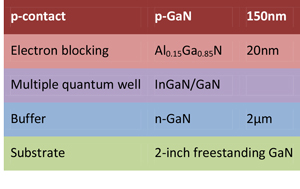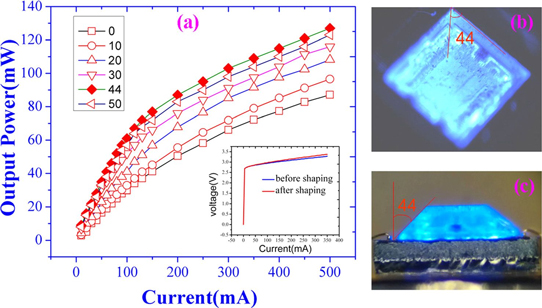- News
6 August 2013
Laser sculpting increases nitride LED extraction by up to 46%
Researchers in China have used laser micromachining to boost light extraction efficiencies of nitride semiconductor light-emitting diodes (LEDs) by up to 46% [Bo Sun et al, J. Appl. Phys., vol113, p243104, 2013]. The team was based at Chinese Academy of Sciences’ Institute of Semiconductors and Tsinghua University.
Light extraction is restricted in nitride semiconductors due to the large difference in refractive index compared with air. For gallium nitride (GaN) the escape cone is restricted to an angle of around 24°. The rest of the light is reflected back into the material.
 Figure 1. Epitaxial structure with indium gallium nitride (InGaN) wells and aluminium gallium nitride (AlGaN) electron-blocking layer.
Figure 1. Epitaxial structure with indium gallium nitride (InGaN) wells and aluminium gallium nitride (AlGaN) electron-blocking layer.
The epitaxial structure for the LEDs (Figure 1) was grown on 2-inch low-defect-density free-standing GaN substrate using metal-organic chemical vapor deposition (MOCVD). The 1mm x 1mm device mesas were etched with inductively coupled plasma. The walls of the mesa were passivated with a silicon dioxide layer. The top p-electrode consisted of a reflective metal stack of nickel-silver-platinum-gold. The structure was then annealed at 550°C for 5 minutes in air. The n-contact consisted of titanium-aluminium-titanium-gold.
The GaN substrate was then sculpted into a truncated pyramid using laser micromachining (Figure 2). The chips were then flip-chip submounted on silicon.

Figure 2. Schematics of conventional flip-chip bulk-GaN LEDs (a) and truncated-pyramidal-shaped flip-chip bulk-GaN LEDs (b).
The aim of the shaping was to improve light extraction by optimizing the positions of the escape cones from the various light emission surfaces with respect to the generation process. The researchers used two-dimensional finite difference and Monte Carlo ray tracing simulations to achieve this. The researchers simulated a range of set ups including different inclination angles of the truncated pyramid, chip size and chip shape (rectangle, triangle or hexagon).

Figure 3. (a) Light output power versus current (L-I) characteristics of truncated-pyramid-shaped LEDs (from inclination angle 0° to 50°) and reference LEDs. Inset current versus voltage (I-V) curve of LEDs before and after laser shaping. (b) Tilt and (c) cross-section views of optical micrographs (with inclination angle 44°) at 5mA injection current.
With the actually constructed chips, the light output power increased with inclination angle up to 44° (Figure 3). The researchers say that this result was consistent with their simulations. Further, the 44° truncated pyramid shape gave up to a 46% enhancement over a non-shaped chip. The researchers also found that the angular distribution of the radiation was in “good agreement” with the simulations.
GaN LEDs MOCVD light extraction pyramid
http://link.aip.org/link/doi/10.1063/1.4812464
The author Mike Cooke is a freelance technology journalist who has worked in the semiconductor and advanced technology sectors since 1997.





